TIPM Plug-In Fuel Pump Relay Bypass/Test System2007-2016 Dodge/Chrysler/Jeep/VW

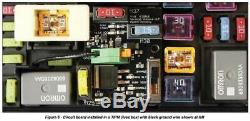
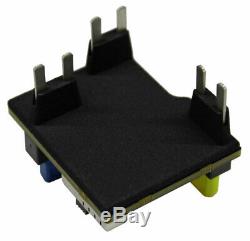
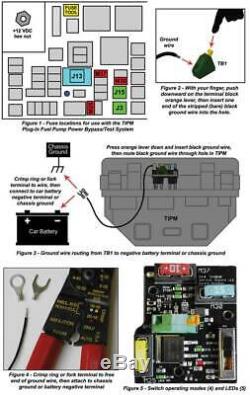
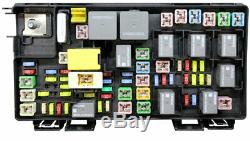


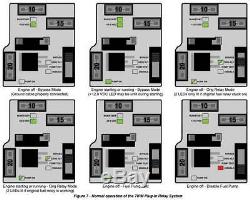
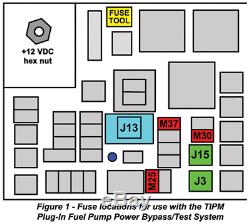
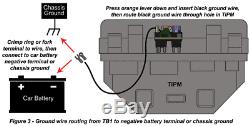

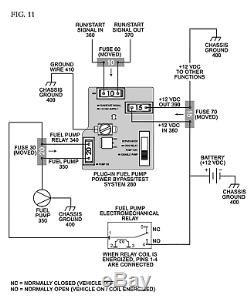

Our TIPM Plug-In Fuel Pump Power Bypass/Test System (US Patent #10,139,450) is a reliable, long-term solution for faulty fuel pump relays on many. This device can bypass a faulty fuel pump relay to continue driving normally, test your fuel pump when the vehicle is off, test your fuel pump relay, and disable the fuel pump as a security measure. If your vehicle fails to start (acts likes it's out of gas) and/or your fuel pump continues pumping after turning the vehicle off (draining your battery), you likely have a faulty fuel pump relay. Fuel pump relays are soldered to one of six circuit boards located deep inside your fuse box (TIPM), so they are very difficult to access and change. Our company, Vertical Visions LLC, is a West Virginia small business that is owned and operated by an engineer who specializes in TIPM and fuel pump relay problems.
Symptoms of Faulty Fuel Pump Relays. The fuel pump relay, located deep inside the TIPM, is the most common relay to fail since it's powered 100% of the time while you're driving. Multiple attempts to start, occurring most often in the morning when the vehicle is cold. The problem gets worse over time and eventually won't start at all.
Unexplained battery drainage due to a relay that is stuck in the closed/on position. You can likely hear the fuel pump running if listening from the rear of the vehicle after it's turned off.
Battery drainage may still occur even after a new battery or fuel pump is installed. The vehicle stalls while driving and you coast to a stop. This situation is sometimes fuel pump relay related. The vehicle won't start and appears to be out of gas.
TIPM Plug-In Fuel Pump Power Bypass/Test System (Isometric View). Designed around a printed circuit board with six terminals (male pins), this advanced system plugs into any TIPM-7 fuse box (see included image) to test and bypass a faulty fuel pump relay using Metal-Oxide Semiconductor Field-Effect Transistors (MOSFETs).
There is no need to cut harness wires, remove the TIPM, visit your dealer, or reprogram the TIPM. The following electrical connections to the vehicle's fuse slots are used: +12 VDC power (M30), run/start signal (M37), fuel pump relay output (M25 far side), power output to the fuel pump (M25 near side), and ground. Installation requires no special skills and can be accomplished in 15 minutes with no vehicle downtime. Once the system is installed, your vehicles fuel pump will receive power with full remote start capabilities and no limitations. Bypass your faulty fuel pump relay to stay on the road and drive like you normally do (Prevents "stuck on" faulty fuel pump relays from draining your battery and will provide power to your fuel pump if the faulty fuel pump relay cannot). Test your existing internal fuel pump relay with LED feedback to determine if it's faulty. Test your fuel pump when the vehicle is off (or drain the tank if the wrong fuel was used). Disable the fuel pump (security mode) so no one can drive the vehicle. LED feedback identifies low battery voltage. Fits under your TIPM lid when closed. This TIPM Plug-In Relay System works exclusively on the TIPM-7 fuse box shown above. TIPM Plug-In Fuel Pump Power Bypass/Test System v4. Ground wire with ring and fork terminals. Low profile 30 amp and 40 amp cartridge fuses. Hard copy color installation manual.Best long term solution for a faulty fuel pump relay. No programming or expensive dealer visits. Eliminates the need for a used TIPM, repaired TIPM, or external relay.
Removes power to the fuel pump after a crash. No special skills required for installation. TIPM Plug-In Relay System Instructions. If you allowed your dealer to install an external relay by cutting wires under your TIPM. Must be used with a TIPM-7 series fuse box. See our applicable vehicle list below to confirm if this part will fit. It's normal to have mini-blade and cartridge fuses in different locations on this style TIPM, depending on your vehicle options and model. A printed color copy of these instructions is included with each order. The four position silver switch (SW1) provides the following functionality. Bypass Mode - Use this mode for normal driving to bypass the fuel pump relay inside your TIPM. It uses the vehicle's run/start +12 VDC signal at the M37 fuse terminal to provide power to the fuel pump via the onboard MOSFET. Original Relay - Use this mode if you want to test the fuel pump relay inside your TIPM or allow it to drive the fuel pump. This switch position uses the original +12 VDC fuel pump relay output from the upper M25 terminal to provide power to the fuel pump via the onboard MOSFET.A green "ORIG RELAY" LED will be illuminated when the +12 VDC signal supplied via the original fuel pump relay is detected. If the original fuel pump relay +12 VDC signal is intermittent or not present (an indication its faulty), this green LED and power output to the fuel pump will mimic it. Fuel Pump Test - This switch position permits the user to test the fuel pump when the vehicle is on or off in order to confirm proper electrical operation. This mode can also be used to drain/service the fuel tank by pumping fuel out when the vehicle is off.
When placed in this mode, +12 VDC is provided to the fuel pump via the onboard MOSFET. You should be able to hear your fuel pump operating by listening for a pumping/motor sound with your ear close to the fuel tank in a quiet environment. Disable Fuel Pump - This switch position completely disables power to the onboard MOSFETs and the fuel pump, serving as an anti-theft device. A red LED is illuminated to indicate the fuel pump is disabled. The circuit board contains five LEDs that provide feedback to the user.
These LEDs draw very little current, so they won't drain your battery if illuminated when the vehicle is off. RUN/START LED - Turns on when the +12 VDC run/start signal is available across the M37 fuse, which indicates the engine is starting or running. +12 VDC power is supplied to the fuel pump if the switch is in bypass mode and this LED is illuminated.+12.0 VDC LED - Indicates the ground wire is properly connected and +12.0 VDC or greater battery supply is available as the main power source. This LED should be on all the time, unless the ground wire is not properly connected or the battery is less than +12.0 VDC. In some vehicles, this LED will not be illuminated during engine cranking due to a temporary voltage drop, which is normal. When the vehicle is powered off, this is the only LED that is illuminated. ORIG RLY LED - Will be illuminated when the +12 VDC signal supplied via the original fuel pump relay inside your TIPM is detected and the switch is in the Original Relay position.
If the original fuel pump relay +12 VDC signal is intermittent or not present (an indication that its faulty), this LED and the power supplied to the fuel pump will mimic it. LED feedback is used to determine if the vehicle's original fuel pump relay is faulty.
DISABLE LED - When the switch is in the DISABLE position, a red LED will be illuminated showing the user that the anti-theft fuel pump disable mode is selected. No power is provided to the fuel pump and the vehicle will not start. PUMP ON LED - If power is present at the M25 20 amp fuse and to the fuel pump, this LED will be illuminated. If no light is present, no power is provided to your fuel pump.
If your vehicle will not start while this LED is illuminated, you may have a fuel pump or other problem. Turn vehicle off and remove your negative battery terminal to disconnect power to the TIPM. This will prevent accidental short circuits.
Using the mini-blade/cartridge fuse removal tool located near the top of your TIPM see Figure 1 - shown in. , remove three existing mini-blade fuses M25, M30, and M37 see Figure 1 - shown in. Insert the three fuses into the corresponding fuse slots in the circuit board. Using the mini-blade/cartridge fuse removal tool, remove two cartridge fuses J3 and J15 from your TIPM see Figure 1 - shown in. Make sure the fuse amp ratings are identical after replacement. For example, remove your J15 40 amp cartridge fuse and replace it with the included 40 amp low profile cartridge fuse. The included low profile cartridge fuses allow the circuit board to fit in your TIPM. Note that some vehicles, such as the Dodge Ram, contain only one cartridge fuse that needs replaced (J15) since J3 is empty. Insert the circuit board into the TIPM so the six male terminals slide into the M25, M30, and M37 fuse slots at the same time. If required, lift up the J13 fuse bezel approximately 1/4 see Figure 1 - shown in. J13 is your Ignition Off Draw (IOD) fuse, which is normally used to prevent battery drainage when the vehicle is not driven for many weeks. The circuit board is fully inserted when the top of the yellow M25 fuse is nearly flush with the Omron grey plug-in relay located directly to the left. Close and then open the TIPM lid to ensure the circuit board is fully seated.The lid should close normally. The included black ground wire must be connected from the circuit board's green ground terminal (TB1) to your vehicle's chassis ground or negative battery terminal. Chassis ground is any conductive connection between the vehicle frame and the car battery's negative terminal. Push the orange lever down on the green ground terminal and simultaneously insert one stripped end of the black ground wire into the opening (see Figure 2). Release the orange lever and pull on the black ground wire to make sure it is secured.
Straighten the free end of the ground wire and insert it through the. Hole in the TIPM shown in Figure 1. The wire will exit under the TIPM where it can be retrieved. Using a crimping tool or pliers, attach the included ring terminal to the free end of the 20 AWG black ground wire as shown in Figures 3 and 4. The included fork terminal can be used instead of the ring terminal in situations where the chassis ground screw can only be loosened.
The ring or fork terminal can then be connected to the vehicle's chassis ground or negative battery terminal to complete the connection. See Figure 3 for details. Reconnect your vehicle's negative battery terminal and you're ready to use the circuit board to test your existing fuel pump relay, test your fuel pump, bypass a faulty fuel pump relay, or put the system into security mode to prevent it from starting.When the ground wire is properly connected, a green Light Emitting Diode (LED) labeled +12.0 VDC will illuminate. This LED confirms that the vehicle has a battery voltage of +12.0 volts or more and the circuit board is connected properly. If the LED is not illuminated, change or check your ground connection and verify your battery is fully charged. 1 After installation, a "NO FUSE" light is illuminated on my instrument panel.
Simply push down on your J13 fuse (with white bezel). This fuse is sometimes lifted up during the installation of the TIPM Plug-In Relay Circuit Board and it must be pushed down when complete.
J13 is your Ignition Off Draw (IOD) fuse that is normally lifted up to prevent battery drainage during long periods of time where the vehicle is not used ie. While at the airport during long vacations. Push it down all the way and all should be fine. 2 When I turn my car off, the "+12 VOLTS" green LED is still lit. Answer: It's quite normal. This LED indicates your battery has at least +12 VDC and sufficient battery power to start the car.The LED draws very little current and will not drain your battery. Many vehicles have other LEDs that are lit when the vehicle is off, such as a red security light, which is completely normal. 3 The "+12 VOLTS" green LED was illuminated when I first installed the part, but now it's out when the vehicle is off. Answer: The green ground wire likely has a bad connection to chassis ground or the battery negative terminal.
Verify that the green ground wire is connected to a bare metal chassis ground connection (no paint). This adjustment can be performed while the battery is connected to help you find the correct connection.
The "+12 VOLTS" green LED will illuminate when properly connected. If you cannot get this LED to illuminated, you may have a battery that is less than 12.0 VDC. Verify battery voltage with a multimeter, if possible. 4 The fuel pump relay inside my TIPM is faulty and stuck in the on position (draining my battery). When I install the TIPM Plug-In Relay System, will this present a problem? Our system is designed to completely disconnect a faulty fuel pump relay from the fuel pump circuit. If you move the device's switch to "bypass mode", the old faulty relay is not connected to the fuel pump in any way. However, our device can optionally use the original faulty relay to drive the fuel pump, if you so choose. The "ORIG RELAY" switch position is often used for testing purposes where a green LED can provide feedback indicating whether or not the faulty fuel relay is providing +12 VDC to the fuel pump.5 My car still won't start after installing your system. Verify the Ignition Off Draw (IOD) J13 fuse with a white bezel around it is pushed down all the way. This fuse is shown in images above and below.
During installation, this fuse may have been lifted up slightly to allow for installation of the TIPM Plug-In Relay System. Many Dodge Ram vehicles will not have a J3 fuse installed. Your HVAC system will not work if you fail to install one of these fuses.
Visually check the three fuses (M25, M37, and M30) that were removed from your TIPM and inserted into our TIPM Plug-In Relay System to ensure they're not blown. With the vehicle off, you should only see the green 12 VOLTS LED illuminated. This LED indicates that your ground wire is attached properly to the negative battery terminal or chassis ground.
It also indicates that you have at least 12.0 VDC present in your battery. If no LEDs are illuminated, reconnect your green or black ground wire or confirm that your battery voltage is at least 12.0 VDC. Have you checked your fuel pump to confirm it is working?Move the switch to the PUMP TEST position. In this position, you should see the green PUMP ON LED illuminate, indicating that 12 VDC power is being delivered to the fuel pump.
You can also hear the fuel pump if the vehicle is located in a quiet environment. Verify that you see the three green LEDs indicated in the below image during the engine cranking process. The most important thing to remember is that illumination of the green PUMP ON LED is the ultimate goal in delivering 12 VDC power to your fuel pump.
If this LED is illuminated, the TIPM Plug-In Relay System is working properly and the problem is likely elsewhere within your vehicle. Is your fuel gauge working properly? Make sure you don't already have an external relay installed.
If you do, change the external relay. If you allowed your dealer to cut harness wires under the TIPM, our TIPM Plug-In Relay System will not work. A fuel pump pressure test is one additional item to check. Check/replace your camshaft and/or crankshaft sensors. There are dozens of things that can prevent a vehicle from starting, beyond the fuel pump relay issue that our TIPM Plug-In Relay System was designed to solve.
6 My remote start isn't working or the vehicle shuts down after a few seconds when using remote start. Answer: Our TIPM Plug-In Relay System works perfectly with remote start and we often find that these types of problems are the result of the vehicle disabling remote start capabilities before or after the starting process. Most vehicles will disable remote start if all of the following conditions are not met. Check engine light not illuminated. BRAKE switch inactive (brake pedal not pressed). Ignition key removed from ignition switch. Battery at an acceptable charge level. Remote keyless entry PANIC button not pressed. The engine can be started two consecutive times (two 15-minute cycles) with the remote keyless entry transmitter. However, the ignition switch must be cycled to the ON/RUN position before you can repeat the start sequence for a third cycle. With the TIPM Plug-In Relay System in place, remote start problems are normally attributable to one or more of the items listed above if you can start your vehicle with a key or pushbutton, but not with the keyfob. 7 How do I connect the one ground wire that is needed for the circuit board to function? Answer: The ground wire is connected between the grounding stud on the circuit board (the device) and any chassis ground connection on the vehicle. Start by disconnecting your battery, then feed the green ground wire through the prescribed hole in the TIPM where it will emerge on the bottom side.You'll attach a ring or fork terminal (included) to the chassis ground end of the wire by crimping it (with crimps or pliers). Then you'll find a good chassis ground connection, which can be any bolt that screws into the frame of the vehicle. Many vehicles also have a true chassis ground stud located near the TIPM that is a perfect connection point.
Either way, finding a chassis ground is easy and we can help you locate one on your vehicle if needed. We include both ring and fork terminals to facilitate this. Then, you simply insert the other end of the ground wire into the grounding stud on the circuit board and tighten it with a flat head screwdriver. Both ends of the chassis ground wire are wetted ie.
Contain solder to prevent the stranded wire from unwinding. Once you reconnect the negative battery terminal, you'll know if your chassis ground connection is adequate when the green LED labeled "+12 VDC" on the circuit board lights up. This LED indicates that your battery contains a voltage of at least 12 VDC. You can also slide the switch into the "DISABLE" position and a red LED should light up, indicating that the circuit board will not deliver power to the fuel pump and vehicle will not start. These are two great indicators that you've properly connected the ground wire. Normal installation time should be less than 15 minutes. We're currently working on a video that will help explain the chassis ground connection in more detail.8 When I turn the key or push the starter button, nothing happens. Sometimes my vehicle stalls while driving and I lose all power.
Is this part at fault? When a vehicle has no power or starter activity, then it's normally an electrical issue elsewhere in the vehicle. Our part simply delivers power to the fuel pump and does not affect the starter's ability to rotate the engine via the flywheel or deliver power to the entire vehicle. We might suggest the following. Verify proper battery voltage when at rest (12.5 VDC normally) and while running (14.0 VDC roughly). Verify that battery cables are securely connected with no corrosion. Your starter could be the problem if no activity occurs when you turn the key or push the starter button, as we experienced a similar issue with our test vehicle (2011 Durango). Check starter relay on top of TIPM. Swap it with a similar to relay to see if things change. Try your alternate key fob. The original key fob might have low battery voltage and the vehicle won't start due to not detecting it. We understand and will accommodate those who need these parts as fast as possible.Order confirmation emails are sent minutes after each order is placed. Tracking emails are sent when the order ships. Many Ebayers game the system by using our parts for testing purposes, then filing a claim that the part doesn't work. We obviously don't like this. If you have another issue with your vehicle outside the TIPM that our part isn't intended to fix ie.
Your starter won't turn the flywheel, then please do not claim that our part is faulty. We will require additional details from every faulty part claim before complying with a return request. We're a small business (Vertical Visions LLC) located in Bridgeport, WV since 2001. The owner (Jason Bell) is a mechanical engineer with 25 years of engineering experience and three patents.
The item "TIPM Plug-In Fuel Pump Relay Bypass/Test System2007-2016 Dodge/Chrysler/Jeep/VW" is in sale since Wednesday, March 13, 2019. This item is in the category "eBay Motors\Parts & Accessories\Car & Truck Parts\Computer, Chip, Cruise Control\Other". The seller is "verticalvisions" and is located in Bridgeport, West Virginia. This item can be shipped worldwide.
- Country/Region of Manufacture: United States
- Manufacturer Part Number: TIPM7-PCB4
- Brand: Vertical Visions
- Warranty: 2 Year

